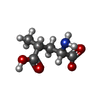[English] 日本語
 Yorodumi
Yorodumi- PDB-5cmm: Crystal structure of the GluK2EM LBD dimer assembly complex with ... -
+ Open data
Open data
- Basic information
Basic information
| Entry | Database: PDB / ID: 5cmm | ||||||
|---|---|---|---|---|---|---|---|
| Title | Crystal structure of the GluK2EM LBD dimer assembly complex with 2S,4R-4-methylglutamate | ||||||
 Components Components | Glutamate receptor ionotropic, kainate 2 | ||||||
 Keywords Keywords |  TRANSPORT PROTEIN / TRANSPORT PROTEIN /  Membrane protein Membrane protein | ||||||
| Function / homology |  Function and homology information Function and homology informationActivation of Na-permeable kainate receptors /  mossy fiber rosette / detection of cold stimulus involved in thermoception / Activation of Na-permeable kainate receptors / kainate selective glutamate receptor complex / Activation of Ca-permeable Kainate Receptor / negative regulation of synaptic transmission, glutamatergic / regulation of short-term neuronal synaptic plasticity / mossy fiber rosette / detection of cold stimulus involved in thermoception / Activation of Na-permeable kainate receptors / kainate selective glutamate receptor complex / Activation of Ca-permeable Kainate Receptor / negative regulation of synaptic transmission, glutamatergic / regulation of short-term neuronal synaptic plasticity /  inhibitory postsynaptic potential / glutamate receptor signaling pathway ...Activation of Na-permeable kainate receptors / inhibitory postsynaptic potential / glutamate receptor signaling pathway ...Activation of Na-permeable kainate receptors /  mossy fiber rosette / detection of cold stimulus involved in thermoception / Activation of Na-permeable kainate receptors / kainate selective glutamate receptor complex / Activation of Ca-permeable Kainate Receptor / negative regulation of synaptic transmission, glutamatergic / regulation of short-term neuronal synaptic plasticity / mossy fiber rosette / detection of cold stimulus involved in thermoception / Activation of Na-permeable kainate receptors / kainate selective glutamate receptor complex / Activation of Ca-permeable Kainate Receptor / negative regulation of synaptic transmission, glutamatergic / regulation of short-term neuronal synaptic plasticity /  inhibitory postsynaptic potential / glutamate receptor signaling pathway / inhibitory postsynaptic potential / glutamate receptor signaling pathway /  glutamate receptor activity / ubiquitin conjugating enzyme binding / Activation of Ca-permeable Kainate Receptor / receptor clustering / modulation of excitatory postsynaptic potential / neuronal action potential / regulation of JNK cascade / kainate selective glutamate receptor activity / glutamate receptor activity / ubiquitin conjugating enzyme binding / Activation of Ca-permeable Kainate Receptor / receptor clustering / modulation of excitatory postsynaptic potential / neuronal action potential / regulation of JNK cascade / kainate selective glutamate receptor activity /  ionotropic glutamate receptor complex / extracellularly glutamate-gated ion channel activity / behavioral fear response / positive regulation of synaptic transmission / glutamate-gated receptor activity / ligand-gated monoatomic ion channel activity involved in regulation of presynaptic membrane potential / ionotropic glutamate receptor complex / extracellularly glutamate-gated ion channel activity / behavioral fear response / positive regulation of synaptic transmission / glutamate-gated receptor activity / ligand-gated monoatomic ion channel activity involved in regulation of presynaptic membrane potential /  excitatory postsynaptic potential / hippocampal mossy fiber to CA3 synapse / presynaptic modulation of chemical synaptic transmission / excitatory postsynaptic potential / hippocampal mossy fiber to CA3 synapse / presynaptic modulation of chemical synaptic transmission /  regulation of membrane potential / dendrite cytoplasm / regulation of membrane potential / dendrite cytoplasm /  SNARE binding / transmitter-gated monoatomic ion channel activity involved in regulation of postsynaptic membrane potential / SNARE binding / transmitter-gated monoatomic ion channel activity involved in regulation of postsynaptic membrane potential /  synaptic transmission, glutamatergic / synaptic transmission, glutamatergic /  PDZ domain binding / postsynaptic density membrane / regulation of long-term neuronal synaptic plasticity / modulation of chemical synaptic transmission / PDZ domain binding / postsynaptic density membrane / regulation of long-term neuronal synaptic plasticity / modulation of chemical synaptic transmission /  terminal bouton / intracellular calcium ion homeostasis / positive regulation of neuron apoptotic process / terminal bouton / intracellular calcium ion homeostasis / positive regulation of neuron apoptotic process /  presynaptic membrane / chemical synaptic transmission / presynaptic membrane / chemical synaptic transmission /  perikaryon / perikaryon /  scaffold protein binding / scaffold protein binding /  postsynaptic membrane / neuron apoptotic process / negative regulation of neuron apoptotic process / postsynaptic membrane / neuron apoptotic process / negative regulation of neuron apoptotic process /  postsynaptic density / postsynaptic density /  axon / axon /  dendrite / neuronal cell body / glutamatergic synapse / dendrite / neuronal cell body / glutamatergic synapse /  synapse / synapse /  ubiquitin protein ligase binding / ubiquitin protein ligase binding /  membrane / identical protein binding / membrane / identical protein binding /  plasma membrane plasma membraneSimilarity search - Function | ||||||
| Biological species |   Rattus norvegicus (Norway rat) Rattus norvegicus (Norway rat)  Homo sapiens (human) Homo sapiens (human) | ||||||
| Method |  X-RAY DIFFRACTION / X-RAY DIFFRACTION /  SYNCHROTRON / SYNCHROTRON /  MOLECULAR REPLACEMENT / Resolution: 1.271 Å MOLECULAR REPLACEMENT / Resolution: 1.271 Å | ||||||
 Authors Authors | Chittori, S. / Mayer, M.L. | ||||||
 Citation Citation |  Journal: Nature / Year: 2016 Journal: Nature / Year: 2016Title: Structural basis of kainate subtype glutamate receptor desensitization. Authors: Joel R Meyerson / Sagar Chittori / Alan Merk / Prashant Rao / Tae Hee Han / Mihaela Serpe / Mark L Mayer / Sriram Subramaniam /  Abstract: Glutamate receptors are ligand-gated tetrameric ion channels that mediate synaptic transmission in the central nervous system. They are instrumental in vertebrate cognition and their dysfunction ...Glutamate receptors are ligand-gated tetrameric ion channels that mediate synaptic transmission in the central nervous system. They are instrumental in vertebrate cognition and their dysfunction underlies diverse diseases. In both the resting and desensitized states of AMPA and kainate receptor subtypes, the ion channels are closed, whereas the ligand-binding domains, which are physically coupled to the channels, adopt markedly different conformations. Without an atomic model for the desensitized state, it is not possible to address a central problem in receptor gating: how the resting and desensitized receptor states both display closed ion channels, although they have major differences in the quaternary structure of the ligand-binding domain. Here, by determining the structure of the kainate receptor GluK2 subtype in its desensitized state by cryo-electron microscopy (cryo-EM) at 3.8 Å resolution, we show that desensitization is characterized by the establishment of a ring-like structure in the ligand-binding domain layer of the receptor. Formation of this 'desensitization ring' is mediated by staggered helix contacts between adjacent subunits, which leads to a pseudo-four-fold symmetric arrangement of the ligand-binding domains, illustrating subtle changes in symmetry that are important for the gating mechanism. Disruption of the desensitization ring is probably the key switch that enables restoration of the receptor to its resting state, thereby completing the gating cycle. | ||||||
| History |
|
- Structure visualization
Structure visualization
| Structure viewer | Molecule:  Molmil Molmil Jmol/JSmol Jmol/JSmol |
|---|
- Downloads & links
Downloads & links
- Download
Download
| PDBx/mmCIF format |  5cmm.cif.gz 5cmm.cif.gz | 172.7 KB | Display |  PDBx/mmCIF format PDBx/mmCIF format |
|---|---|---|---|---|
| PDB format |  pdb5cmm.ent.gz pdb5cmm.ent.gz | 140 KB | Display |  PDB format PDB format |
| PDBx/mmJSON format |  5cmm.json.gz 5cmm.json.gz | Tree view |  PDBx/mmJSON format PDBx/mmJSON format | |
| Others |  Other downloads Other downloads |
-Validation report
| Arichive directory |  https://data.pdbj.org/pub/pdb/validation_reports/cm/5cmm https://data.pdbj.org/pub/pdb/validation_reports/cm/5cmm ftp://data.pdbj.org/pub/pdb/validation_reports/cm/5cmm ftp://data.pdbj.org/pub/pdb/validation_reports/cm/5cmm | HTTPS FTP |
|---|
-Related structure data
| Related structure data |  8289C  8290C  5cmkC  5kufC  5kuhC  1s50S C: citing same article ( S: Starting model for refinement |
|---|---|
| Similar structure data |
- Links
Links
- Assembly
Assembly
| Deposited unit | 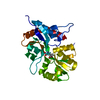
| ||||||||
|---|---|---|---|---|---|---|---|---|---|
| 1 |
| ||||||||
| Unit cell |
|
- Components
Components
| #1: Protein | Mass: 29356.621 Da / Num. of mol.: 1 Fragment: UNP P42260 residues 429-544, UNP Q13002 residues 667-806 Mutation: A487T A658S N690S F704L,A487T A658S N690S F704L Source method: isolated from a genetically manipulated source Source: (gene. exp.)   Rattus norvegicus (Norway rat), (gene. exp.) Rattus norvegicus (Norway rat), (gene. exp.)   Homo sapiens (human) Homo sapiens (human)Gene: Grik2, Glur6, GRIK2, GLUR6 / Plasmid: PET22 / Production host:   Escherichia coli (E. coli) / Strain (production host): Origami B(DE3) / References: UniProt: P42260, UniProt: Q13002 Escherichia coli (E. coli) / Strain (production host): Origami B(DE3) / References: UniProt: P42260, UniProt: Q13002 |
|---|---|
| #2: Chemical | ChemComp-SYM / |
| #3: Water | ChemComp-HOH /  Water Water |
-Experimental details
-Experiment
| Experiment | Method:  X-RAY DIFFRACTION X-RAY DIFFRACTION |
|---|
- Sample preparation
Sample preparation
| Crystal | Density Matthews: 2.29 Å3/Da / Density % sol: 46.25 % |
|---|---|
Crystal grow | Temperature: 291 K / Method: vapor diffusion, hanging drop / pH: 8 Details: Reservoir: 18% PEG 4K Protein buffer: 20 mM NaCl, 5 mM 2S,4R-4-methylglutamate, 1 mM EDTA, 2 mM TRIS pH 8 |
-Data collection
| Diffraction | Mean temperature: 100 K |
|---|---|
| Diffraction source | Source:  SYNCHROTRON / Site: SYNCHROTRON / Site:  APS APS  / Beamline: 22-ID / Wavelength: 1 Å / Beamline: 22-ID / Wavelength: 1 Å |
| Detector | Type: RAYONIX MX300-HS / Detector: CCD / Date: Jul 1, 2015 |
| Radiation | Protocol: SINGLE WAVELENGTH / Monochromatic (M) / Laue (L): M / Scattering type: x-ray |
| Radiation wavelength | Wavelength : 1 Å / Relative weight: 1 : 1 Å / Relative weight: 1 |
| Reflection | Resolution: 1.27→40 Å / Num. obs: 68757 / % possible obs: 99.4 % / Redundancy: 7 % / Rmerge(I) obs: 0.043 / Net I/σ(I): 45.64 |
| Reflection shell | Resolution: 1.27→1.29 Å / Redundancy: 4.7 % / Rmerge(I) obs: 0.335 / Mean I/σ(I) obs: 3.8 / % possible all: 95.2 |
- Processing
Processing
| Software |
| |||||||||||||||||||||||||||||||||||||||||||||||||||||||||||||||||||||||||||||||||||||||||||||||||||||||||||||||||||||||||||||||||||||||||||||||||||||||||||||||||||||||||||||||||||||||||||||||||||||||||||||||||||||||||
|---|---|---|---|---|---|---|---|---|---|---|---|---|---|---|---|---|---|---|---|---|---|---|---|---|---|---|---|---|---|---|---|---|---|---|---|---|---|---|---|---|---|---|---|---|---|---|---|---|---|---|---|---|---|---|---|---|---|---|---|---|---|---|---|---|---|---|---|---|---|---|---|---|---|---|---|---|---|---|---|---|---|---|---|---|---|---|---|---|---|---|---|---|---|---|---|---|---|---|---|---|---|---|---|---|---|---|---|---|---|---|---|---|---|---|---|---|---|---|---|---|---|---|---|---|---|---|---|---|---|---|---|---|---|---|---|---|---|---|---|---|---|---|---|---|---|---|---|---|---|---|---|---|---|---|---|---|---|---|---|---|---|---|---|---|---|---|---|---|---|---|---|---|---|---|---|---|---|---|---|---|---|---|---|---|---|---|---|---|---|---|---|---|---|---|---|---|---|---|---|---|---|---|---|---|---|---|---|---|---|---|---|---|---|---|---|---|---|---|
| Refinement | Method to determine structure : :  MOLECULAR REPLACEMENT MOLECULAR REPLACEMENTStarting model: 1S50 Resolution: 1.271→27.287 Å / SU ML: 0.12 / Cross valid method: THROUGHOUT / σ(F): 0.17 / Phase error: 16.51 / Stereochemistry target values: ML
| |||||||||||||||||||||||||||||||||||||||||||||||||||||||||||||||||||||||||||||||||||||||||||||||||||||||||||||||||||||||||||||||||||||||||||||||||||||||||||||||||||||||||||||||||||||||||||||||||||||||||||||||||||||||||
| Solvent computation | Shrinkage radii: 0.9 Å / VDW probe radii: 1.11 Å / Solvent model: FLAT BULK SOLVENT MODEL | |||||||||||||||||||||||||||||||||||||||||||||||||||||||||||||||||||||||||||||||||||||||||||||||||||||||||||||||||||||||||||||||||||||||||||||||||||||||||||||||||||||||||||||||||||||||||||||||||||||||||||||||||||||||||
| Refinement step | Cycle: LAST / Resolution: 1.271→27.287 Å
| |||||||||||||||||||||||||||||||||||||||||||||||||||||||||||||||||||||||||||||||||||||||||||||||||||||||||||||||||||||||||||||||||||||||||||||||||||||||||||||||||||||||||||||||||||||||||||||||||||||||||||||||||||||||||
| Refine LS restraints |
| |||||||||||||||||||||||||||||||||||||||||||||||||||||||||||||||||||||||||||||||||||||||||||||||||||||||||||||||||||||||||||||||||||||||||||||||||||||||||||||||||||||||||||||||||||||||||||||||||||||||||||||||||||||||||
| LS refinement shell |
|
 Movie
Movie Controller
Controller


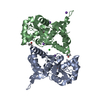



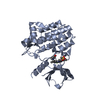



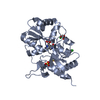



 PDBj
PDBj




